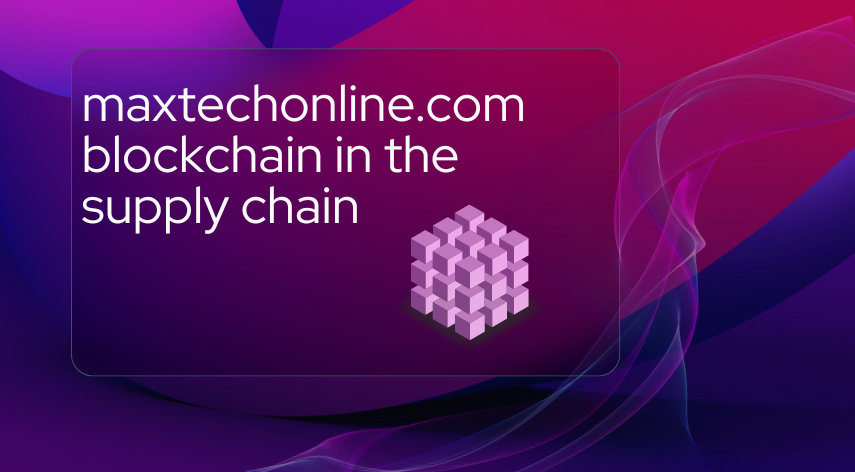Maxtechonline.com blockchain in the supply chain has emerged as a disruptive force across various industries, and its application in supply chain management is revolutionizing the way businesses operate. In this article, we will delve into the intricacies of blockchain in the supply chain, exploring its definition, benefits, challenges, and real-life examples.
1. Introduction to Blockchain in Supply Chain
Blockchain technology, initially synonymous with cryptocurrencies like Bitcoin, has evolved into a robust solution for enhancing transparency, security, and efficiency in supply chain management. At its core, blockchain is a decentralized ledger that records transactions across multiple computers in a way that ensures the integrity and immutability of the data.
2. Understanding Blockchain Technology
What is blockchain?
Blockchain is a distributed ledger technology (DLT) that enables the secure recording and sharing of transactions in a tamper-proof and transparent manner. Each block in the chain contains a timestamp and a link to the previous block, forming a chronological and immutable record of transactions.
How does blockchain work?
When a transaction occurs, it is verified by network participants and added to a block. This block is then appended to the existing chain of blocks, creating a permanent and transparent record. Cryptography ensures the security and integrity of the data, making it virtually impossible to alter or counterfeit.
3. Challenges in Traditional Supply Chains
Traditional supply chains often face challenges such as lack of transparency, inefficiencies, and susceptibility to fraud. These issues can lead to delays, increased costs, and compromised quality control.
4. Benefits of Implementing Blockchain
Increased transparency and traceability
Blockchain provides a transparent and immutable record of transactions, enabling stakeholders to track the movement of goods from the point of origin to the final destination. This transparency enhances trust and accountability throughout the supply chain.
Improved efficiency and cost savings
By streamlining processes and reducing manual intervention, blockchain can optimize supply chain operations, leading to cost savings and faster transaction times. Smart contracts, which automate contractual agreements and execution, further enhance efficiency.
Enhanced security and fraud prevention
Blockchain’s decentralized nature and cryptographic algorithms make it highly secure against tampering and fraud. By digitizing and securing supply chain data, blockchain mitigates the risk of counterfeit goods and unauthorized modifications.
5. Real-life Examples of Blockchain in Supply Chain
Walmart’s use of blockchain for food safety
Walmart implemented blockchain technology to track the movement of food products from farm to store, enabling rapid traceability in the event of contamination or recalls. This initiative has enhanced food safety standards and regulatory compliance.
Maersk and IBM’s TradeLens platform
Maersk and IBM collaborated to develop TradeLens, a blockchain-based platform for global trade management. By digitizing and automating supply chain processes, TradeLens reduces paperwork, delays, and disputes, resulting in a more efficient and transparent supply chain.
6. Integration of Blockchain into Supply Chain Processes
Blockchain can be integrated into various supply chain processes to improve transparency, efficiency, and trust among stakeholders.
Product tracking and tracing
Blockchain enables real-time tracking and tracing of products throughout the supply chain, providing stakeholders with visibility into the movement, condition, and ownership of goods.
Smart contracts for automated transactions
Smart contracts, self-executing contracts with predefined rules and conditions, automate transactions and enforce contractual agreements without the need for intermediaries. This reduces delays, errors, and disputes in supply chain transactions.
7. Potential Future Developments
Expansion of blockchain applications
As blockchain technology matures, its applications in supply chain management are expected to expand beyond tracking and tracing to include areas such as inventory management, procurement, and regulatory compliance.
Integration with Internet of Things (IoT)
The integration of blockchain with IoT devices, such as sensors and RFID tags, will enable real-time data collection and secure sharing of information across the supply chain. This convergence of technologies will enhance visibility, efficiency, and predictive analytics.
8. Challenges and Concerns
Scalability issues
The scalability of blockchain networks remains a challenge, particularly as the volume of transactions increases. Scalability solutions such as sharding and off-chain protocols are being developed to address this limitation.
Regulatory compliance
The regulatory landscape surrounding blockchain technology is still evolving, with concerns regarding data privacy, intellectual property rights, and cross-border transactions. Businesses must navigate these regulatory complexities to ensure compliance and legal certainty.
9. Conclusion
Blockchain technology holds immense promise for transforming supply chain management by enhancing transparency, efficiency, and security. As businesses continue to explore its potential, collaboration, innovation, and regulatory clarity will be crucial for realizing the full benefits of blockchain in the supply chain.
10. FAQs
- What industries can benefit from blockchain in the supply chain?
- Various industries, including food and beverage, pharmaceuticals, logistics, and manufacturing, can benefit from blockchain technology to enhance transparency and traceability in their supply chains.
- How can small and medium-sized enterprises (SMEs) leverage blockchain in their supply chains?
- SMEs can collaborate with blockchain service providers or industry consortia to access blockchain solutions tailored to their needs. Additionally, they can explore blockchain-as-a-service (BaaS) offerings to minimize upfront costs and technical barriers.
- What role do regulators play in the adoption of blockchain in the supply chain?
- Regulators play a crucial role in establishing standards, frameworks, and guidelines for blockchain adoption in the supply chain. By providing clarity on legal and regulatory requirements, regulators can facilitate innovation while ensuring consumer protection and data privacy.
- How does blockchain address the issue of counterfeit goods in the supply chain?
- Blockchain enables the creation of a transparent and immutable record of product authenticity, making it difficult for counterfeiters to infiltrate the supply chain. By verifying the provenance and integrity of goods, blockchain helps mitigate the risk of counterfeit products entering the market.
- What are the potential risks associated with blockchain implementation in the supply chain?
- Risks associated with blockchain implementation include technical challenges, such as scalability and interoperability, as well as regulatory and legal uncertainties. Businesses must conduct thorough risk assessments and adopt robust governance frameworks to mitigate these risks effectively.
